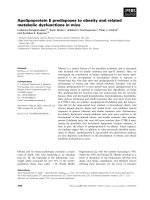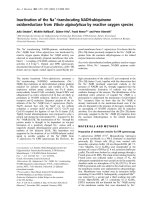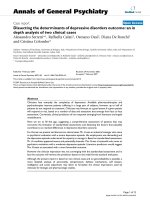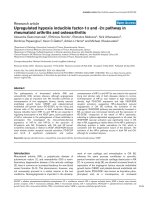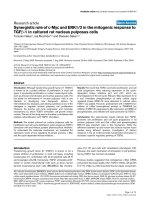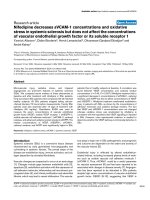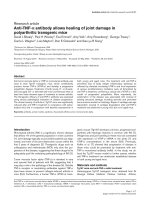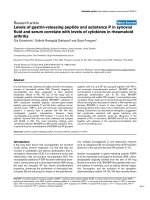Báo cáo y học: "Adiponectin may contribute to synovitis and joint destruction in rheumatoid arthritis by stimulating vascular endothelial" pot
Bạn đang xem bản rút gọn của tài liệu. Xem và tải ngay bản đầy đủ của tài liệu tại đây (1.51 MB, 10 trang )
Open Access
Available online />Page 1 of 10
(page number not for citation purposes)
Vol 11 No 6
Research article
Adiponectin may contribute to synovitis and joint destruction in
rheumatoid arthritis by stimulating vascular endothelial growth
factor, matrix metalloproteinase-1, and matrix
metalloproteinase-13 expression in fibroblast-like synoviocytes
more than proinflammatory mediators
Hyun-Mi Choi
1
, Yeon-Ah Lee
2
, Sang-Hoon Lee
3
, Seung-Jae Hong
2
, Dae-Hyun Hahm
4
, Sang-
Yun Choi
5
, Hyung-In Yang
3
, Myung Chul Yoo
1
and Kyoung Soo Kim
1
1
East-West Bone & Joint Research Institute, East-West Neo Medical Center, Kyung Hee University, 149 Sangil-dong, Gangdong-gu, Seoul, 134-
727, Republic of Korea
2
Division of Rheumatology, Department of Internal Medicine, College of Medicine, Kyung Hee University, Hoegi-1-dong, Dongdaemun-gu, Seoul, 130-
702, Republic of Korea
3
Division of Rheumatology, Department of Internal Medicine, East-West Neo Medical Center, Kyung Hee University, 149 Sangil-dong, Gangdong-gu,
Seoul, 134-727, Republic of Korea
4
Acupuncture and Meridian Science Research Center, Kyung Hee University, Hoeggi-dong, Dongdaemoon-gu, Seoul, 130-702, Republic of Korea
5
School of Life Sciences and Biotechnology, Anam-dong Seongbuk-gu, Korea University, Seoul, 136-701, Republic of Korea
Corresponding author: Myung Chul Yoo, Soo Kim,
Received: 19 Jun 2009 Revisions requested: 4 Aug 2009 Revisions received: 30 Sep 2009 Accepted: 2 Nov 2009 Published: 2 Nov 2009
Arthritis Research & Therapy 2009, 11:R161 (doi:10.1186/ar2844)
This article is online at: />© 2009 Choi et al.; licensee BioMed Central Ltd.
This is an open access article distributed under the terms of the Creative Commons Attribution License ( />),
which permits unrestricted use, distribution, and reproduction in any medium, provided the original work is properly cited.
Abstract
Introduction The role of adiponectin in the pathogenesis of
arthritis is still controversial. This study was performed to
examine whether adiponectin is involved in joint inflammation
and destruction in rheumatoid arthritis (RA) in relation to the
expression of vascular endothelial growth factor (VEGF) and
matrix metalloproteinases (MMPs).
Methods Synovial cells from RA patients were treated with
adiponectin or interleukin (IL)-1β for 24 hours. The culture
supernatant was collected and analyzed for the levels of IL-6, IL-
8, prostaglandin E
2
(PGE
2
), VEGF, and MMPs by enzyme-linked
immunosorbent assay. The levels of adiponectin, VEGF, MMP-
1, and MMP-13 in the joint fluids from 30 RA or osteoarthritis
(OA) patients were also measured.
Results Adiponectin at the concentration of 10 μg/mL
stimulated the production of IL-6, IL-8, and PGE
2
in RA
fibroblast-like synoviocytes (FLSs), although the level of these
was much lower than with 1 ng/mL IL-1β. However, adiponectin
stimulated the production of VEGF, MMP-1, and MMP-13 at the
same level as IL-1β. In addition, the level of adiponectin and
MMP-1 in the joint fluid of RA patients was significantly higher
than in OA patients. Adiponectin was positively correlated with
VEGF in RA patients but not in OA patients, while the level of
MMPs in joint fluid was not correlated with adiponectin in either
RA or OA patients.
Conclusions Adiponectin may play a significant role in the
pathogenesis of RA by stimulating the production of VEGF and
MMPs in FLSs, leading to joint inflammation and destruction,
respectively.
Introduction
Adipose tissue, once viewed as simply a storage and release
depot for lipids, is now considered an endocrine tissue [1,2]
that secretes various substances (adipokines), including
tumor necrosis factor-alpha (TNF-α), interleukin (IL)-6, leptin,
adiponectin, resistin, visfatin, and omenetin [3,4]. Among
these adipokines, much attention has been paid to adiponec-
tin's relationship with insulin sensitivity and glucose and lipid
COX-2: cyclooxygenase-2; ECL: enhanced chemiluminescence; ELISA: enzyme-linked immunosorbent assay; FLS: fibroblast-like synoviocyte; IL:
interleukin; LPS: lipopolysacchride; MMP: matrix metalloproteinase; OA: osteoarthritis; PCR: polymerase chain reaction; PGE
2
: prostaglandin E
2
; RA:
rheumatoid arthritis; TNF-α: tumor necrosis factor-alpha; VEGF: vascular endothelial growth factor.
Arthritis Research & Therapy Vol 11 No 6 Choi et al.
Page 2 of 10
(page number not for citation purposes)
metabolism in the past 10 years. In addition, adiponectin is
known to exhibit potent anti-inflammatory [5], atheroprotective
[6], and antidiabetic [7] effects.
Recent findings suggest that adiponectin may be involved in
the pathogenesis of rheumatoid arthritis (RA). Levels of adi-
ponectin in synovial fluid and sera were elevated in patients
with RA [8,9]. Adiponectin also induces the production of
proinflammatory cytokines, IL-6, matrix metalloproteinase
(MMP)-1, and IL-8 from RA synovial fibroblasts in vitro
[10,11]. Thus, it was suggested that adiponectin can also
exert significant proinflammatory and matrix-degrading effects.
However, the role of adiponectin in the pathogenesis of RA is
still controversial because of conflicting reports about its func-
tion [10,12-15]. In particular, adiponectin seems to play an
anti-inflammatory role because it significantly inhibited IL-1β-
stimulated synovial cell proliferation in collagen-induced
arthritic mice, despite increased IL-6 expression [16]. In con-
trast, high-grade inflammation in RA patients was negatively
correlated with circulating adiponectin concentrations [17].
Rather, it was suggested that circulating adiponectin may be
involved in cardiovascular disease in RA patients. Although
this contradiction was partly explained by the induction of tol-
erance to inflammatory stimuli by adiponectin [18], the pro- or
anti-inflammatory effects of adiponectin on the pathogenesis
of RA remain unknown.
With regard to adiponectin's proinflammatory effects, we won-
dered whether adiponectin might stimulate the production of
vascular endothelial growth factor (VEGF) and MMPs as well
as proinflammatory mediators like IL-1β and TNF-α do. In this
study, we investigated the stimulatory effect of adiponectin on
the production of IL-6, IL-8, prostaglandin E
2
(PGE
2
), VEGF,
and MMPs. In addition, the correlation between adiponectin
and VEGF or MMPs was investigated by measuring the levels
of these three proteins in the joint fluid of patients with RA or
osteoarthritis (OA).
Materials and methods
Cell culture
All in vitro experiments were carried out with fibroblast-like
synoviocytes (FLSs) derived from patients with RA. After
informed consent was obtained, synovial tissues were col-
lected from RA patients. They met the 1987 American College
of Rheumatology criteria for the diagnosis of RA and had been
treated with nonbiological disease-modifying antirheumatic
drugs and had undergone therapeutic joint surgery. FLSs
were isolated and grown in Dulbecco's modified essential
medium (low glucose) (Gibco-BRL, now part of Invitrogen
Corporation, Carlsbad, CA, USA) supplemented with 10%
(vol/vol) fetal bovine serum (Invitrogen Corporation) and 1×
Antibiotic-Antimycotic (Invitrogen Corporation) as described
previously [19]. After the cells had grown to confluence, they
were split at a 1:4 ratio. FLS passages 3 to 6 from three
patients were used for all experiments. Ethical permission was
obtained from the Institutional Review Board for Human
Research of Kyung Hee University, Neo-Medical Center.
Measurement of gene expression by enzyme-linked
immunosorbent assay
Synovial cells (2.5 × 10
5
cells per 60-mm dish per 2 mL of
serum-free media) were treated with recombinant adiponectin
(1 or 10 μg/mL) or IL-1β (0.1 or 1 ng/mL) (ProSpec, Rehovot,
Israel). Conditioned media was collected 24 hours later.
Briefly, FLS cultures were centrifuged and the supernatants
were collected and analyzed for IL-6, IL-8, PGE
2
, VEGF, MMP-
1, and MMP-13 with an enzyme-linked immunosorbent assay
(ELISA) kit (R&D Systems, Inc., Minneapolis, MN, USA). Three
independent experiments were performed in quadruplicate.
Each experiment was performed using synovial cells from dif-
ferent patients. For the assessment of MMP-1, MMP-13,
VEGF, and adiponectin levels in joint fluid, the collected joint
fluid from 30 patients with RA or OA was dispensed into 1-mL
aliquots and treated with hyaluronadase at 50 μg/mL for 1
hour at room temperature. The joint fluid was diluted with dilu-
ent's buffer for the proper detection range with ELISA. The lev-
els of proteins of interest in joint fluid were measured using a
commercial ELISA kit from R&D Systems, Inc., as described
above.
Real-time polymerase chain reaction
Real-time quantitative polymerase chain reaction (PCR) was
carried out using the LightCycler PCR system (Roche Diag-
nostics, Meylan, France) using the DNA binding SYBR Green
I dye to detect the PCR products as described previously [19].
A serial dilution was used to generate each standard curve.
Each 20-μL reaction mixture contained 1× LightCycler-DNA
master SYBR Green I, a specific primer, and 2 μL of cDNA.
After 2 minutes of denaturation at 95°C, the MMPs, VEGF, IL-
6, IL-8, cyclooxygenase-2 (COX-2), and β-actin underwent 40
reaction cycles at 95°C for 5 seconds, 55°C to 60°C for 10
seconds (annealing), and 72°C for 13 seconds. Product spe-
cificity was determined by melting curve analysis as described
in the LightCycler manual. The results are calculated as ratios
of gene transcripts to β-actin transcripts, with the quantity of
transcripts in each sample expressed as a copy number. The
ratio of MMPs, VEGF, IL-6, IL-8, and COX-2/β-actin mRNA
was assigned a value of 100%, with the corresponding results
calculated as relative percentages. The primers were synthe-
sized by Bioneer Co. Ltd. (Seoul, Korea), and their sequences
are listed in Table 1.
Western blot analysis
FLSs cultured (2.5 × 10
5
cells) in 60-mm dishes were serum-
starved overnight and stimulated by adiponectin (1 or 10 μg/
mL) or IL-1β (0.1 or 1 ng/mL) for 24 hours. The cells were sub-
sequently washed twice in phosphate-buffered saline and
treated with 50 μL of lysis buffer (20 mM Tris-Cl [pH 8.0], 150
mM NaCl, 1 mM EDTA [ethylenediaminetetraacetic acid], 1%
Triton X-100, 20 μg/mL chymostatin, 2 mM PMSF
Available online />Page 3 of 10
(page number not for citation purposes)
[phenylmethylsulphonyl fluoride], 10 μM leupeptin, and 1 mM
AEBSF [4-(2-aminoethyl)benzenesulfonyl fluoride]). The sam-
ples were separated using 12% SDS-PAGE and were then
transferred to Hybond-ECL [enhanced chemiluminescence]
membranes (Amersham, now part of GE Healthcare, Little
Chalfont, Buckinghamshire, UK). The membranes were first
blocked with 6% nonfat milk dissolved in TBST buffer (10 mM
Tris-Cl [pH 8.0], 150 mM NaCl, 0.05% Tween 20). The blots
were then probed with various rabbit polyclonal antibodies for
COX-2 and β-actin (Cell Signaling Technology, Inc., Danvers,
MA, USA) diluted 1:1,000 in Tris-buffered saline at 4°C over-
night and incubated with 1:1,000 dilutions of goat anti-rabbit
IgG secondary antibody coupled with horseradish peroxidase.
The blots were developed using the ECL method (GE Health-
care). For re-probing, the blots were incubated in the stripping
buffer (100 mM 2-mercaptoethanol, 2% SDS, 62.5 mM Tris-
HCl [pH 6.7]) at 50°C for 30 minutes with occasional
agitation.
Statistical analysis
The in vitro experimental data are expressed as the mean ±
standard error of the mean of quadruplicate samples. Differ-
ences between groups were assessed by repeated analysis of
variance followed by the Dunnett multiple comparison test.
The level of MMPs, VEGF, and adiponectin in the joint fluid of
RA and OA patients was compared between groups with the
unpaired t test. To determine the degree of linearity between
two variables, data were compared using the Pearson correla-
tion test (two-tailed). Prism software 4 (GraphPad Software,
Inc., San Diego, CA, USA) was used for statistical analysis and
graphing. Differences were considered significant at a P value
of less than 0.05.
Results
Effect of adiponectin on the production of
proinflammatory mediators in rheumatoid arthritis
fibroblast-like synoviocytes
To evaluate whether adiponectin contributes significantly to
the inflammation of joints in RA patients, the level of proinflam-
matory mediators in response to IL-1β or adiponectin was
compared in FLSs from patients with RA (Figure 1). The RA
synovial cells were treated with 1 or 10 μg/mL adiponectin.
For comparison, the cells were treated with 0.1 or 1 ng/mL IL-
1β. Adiponectin stimulated the production of IL-6 and IL-8 in
RA FLSs, but the production of these proteins was very low in
comparison with that induced by IL-1β in these cells. IL-1β at
1 ng/mL increased the production of IL-6 and IL-8 about five-
fold and ninefold, respectively, compared with adiponectin at
10 μg/mL. In particular, 1 ng/mL IL-1β increased the level of
PGE
2
about 40-fold more than IL-1β at 0.1 ng/mL and adi-
ponectin at 10 μg/mL. Consistent with the protein levels, the
mRNA levels of the respective genes were also increased by
the evaluation of real-time PCR (data not shown). This result
suggests that adiponectin may not greatly induce the produc-
tion of proinflammatory mediators such as IL-6, IL-8, and PGE
2
in FLSs like IL-1β does.
Table 1
The sequence of polymerase chain reaction primers used in this experiment
Primer name Primer sequence Product size
MMP-1 sense 5'-CCT AGC TAC ACC TTC AGT GG-3' 338 bp
MMP-1 antisense 5'-GCC CAG TAC TTA TTC CCT TT-3'
MMP-13 sense 5'-TTG AGG ATA CAG GCA AGA CT-3' 311 bp
MMP-13 antisense 5'-TGG AAG TAT TAC CCC AAA TG-3'
VEGF sense 5'-ACT TCA GGC TCT TCT CCT TT-3' 288 bp
VEGF antisense 5'-TTC AGA CAA CCT GAG TCC TT-3'
IL-6 sense 5'-CTG GTC TTT TGG AGT TTG AG-3' 344 bp
IL-6 antisense 5'-TTT CTG ACC AGA AGA AGG AA-3'
IL-8 sense 5'-ACT TTC AGA GAC AGC AGA GC-3' 264 bp
IL-8 antisense 5'-GTG GTC CAC TCT CAA TCA CT-3'
COX-2 sense 5'-TTC AAA TGA GAT TGT GGG AAA ATT GCT-3' 306 bp
COX-2 antisense 5'-AGA TCA TCT CTG CCT GAG TAT CTT-3'
β-actin sense 5'-TCA TGA GGT AGT CAG TCA GG-3' 305 bp
β-actin antisense 5'-CTT CTA CAA TGA GCT GCG TG-3'
bp, base pairs; COX-2, cyclooxygenase-2; IL, interleukin; MMP, matrix metalloproteinase; VEGF, vascular endothelial growth factor.
Arthritis Research & Therapy Vol 11 No 6 Choi et al.
Page 4 of 10
(page number not for citation purposes)
Effect of adiponectin on the production of vascular
endothelial growth factor and matrix metalloproteinases
in rheumatoid arthritis fibroblast-like synoviocytes
Next, to evaluate whether adiponectin stimulates the produc-
tion of VEGF and MMPs for angiogenesis of pannus and joint
destruction in RA FLSs, VEGF and MMP production was eval-
uated in the supernatants of cell cultures treated with adi-
ponectin or IL-1β (Figure 2). Both adiponectin and IL-1β
strongly stimulated the production of VEGF, MMP-1, and
MMP-13 in RA FLSs. However, the expressions of MMP-2 and
MMP-9 were not increased by either adiponectin or IL-1β at
the mRNA or protein level. Consistent with the mRNA levels
(data not shown), the protein levels of VEGF, MMP-1, and
MMP-13 elevated by treatment with 10 μg/mL adiponectin
were similar to those after treatment with 1 ng/mL IL-1β. The
difference between adiponectin and IL-1β was not statistically
significant, suggesting that adiponetin may have a role in the
production of VEGF and MMPs like IL-1β does.
Correlation of matrix metalloproteinase levels with
adiponectin in the joint fluid of patients
To evaluate whether the in vitro effect of adiponectin on the
expression of VEGF, MMP-1, and MMP-13 is associated with
the expression of these genes in the joint fluid of RA patients,
we measured the levels of adiponectin, VEGF, MMP-1, and
MMP-13 in the joint fluid of RA or OA patients (Figure 3). As
reported previously [8,9], the level of adiponectin was signifi-
cantly elevated in the joint fluid of RA patients compared with
that of OA patients (Figure 3a). The MMP-1 level was also
higher in RA patients than in OA patients (Figure 3b). How-
ever, the level of MMP-13 and VEGF was not significantly dif-
ferent between RA and OA patients (Figure 3c, d). Next, we
checked whether adiponectin levels correlated with VEGF,
MMP-1, and MMP-13 levels in the joint fluid from RA or OA
patients (Figure 4). However, the level of adiponectin did not
positively correlate with MMP levels in the joint fluid of either
RA or OA patients. MMP levels in joint fluid might be affected
by other factors like proinflammatory cytokines and hypoxia or
by unknown factors. However, the adiponectin levels signifi-
cantly and positively correlated with VEGF levels in RA joint
fluid, but not OA joint fluid. This result suggests that adipopec-
tin may play a role in inducing the expression of VEGF in RA
FLSs, leading to angiogenesis and the formation of pannus in
RA patients.
Discussion
Adiponectin is known to play a significant role in the pathogen-
esis of RA, although whether adiponectin acts as an anti-
Figure 1
Comparative effect of adiponectin and interleukin (IL)-1β on the production of IL-6, IL-8, and prostaglandin E
2
(PGE
2
) in rheumatoid arthritis fibrob-last-like synoviocytesComparative effect of adiponectin and interleukin (IL)-1β on the production of IL-6, IL-8, and prostaglandin E
2
(PGE
2
) in rheumatoid arthritis fibrob-
last-like synoviocytes. IL-1β at 1 ng/mL stimulates the production of (a) IL-6, (b) IL-8, and (c) PGE
2
more than 10 μg/mL adiponectin. (d) The expres-
sion of cycloxygenase-2 (COX-2) increased only in the presence of IL-1β in proportion to the level of PGE
2
. The data shown are representative of
three independent experiments, and similar results were obtained from all three. Values are expressed as mean ± standard error of the mean. * P <
0.05, ** P < 0.01 versus nontreated group. ns, not significant.
Available online />Page 5 of 10
(page number not for citation purposes)
inflammatory or proinflammatory mediator is controversial.
Assuming that adiponectin plays a role in the pathogenesis of
arthritis as a proinflammatory mediator, we tried to determine
how significantly adiponectin contributes to joint inflammation
and destruction compared with another proinflammatory
cytokine, IL-1β. Thus, we evaluated the effect of adiponectin
on the production of the proinflammatory mediators VEGF and
MMPs and compared the result with that of IL-1β, one of the
major proinflammatory cytokines in RA FLSs.
In this study, RA FLSs stimulated with 10 μg/mL adiponectin
increased the production of IL-6, IL-8, and PGE
2
. However,
the level of these proteins was low in comparison with that of
RA FLSs stimulated with 1 ng/mL IL-1β. Adiponectin also
greatly increased the mRNA and protein levels of colla-
genases (MMP-1 and MMP-13) and VEGF. MMPs and VEGF
were elevated to a level comparable to that of IL-1β in RA
FLSs. Interestingly, the mRNA and protein levels of gelati-
nases (MMP-2 and MMP-9) were not stimulated by either adi-
ponectin or IL-1β. These results are consistent with some, but
not all, previous results. Ehling and colleagues [10] reported
that adiponectin increased the expression of pro-MMP-1 and
IL-6 in RA FLSs, but not pro-MMP-13. In addition, adiponectin
stimulated the expression of MMP-9, but not MMP-2, in cul-
tured murine chondrocytes [20].
Some questions about this effect may be raised. First, the
human recombinant adiponectin protein used in these studies
is a single nonglycosylated polypeptide chain produced in
Escherichia coli with a molecular weight of 25.1 kDa and con-
taining 231 amino acids. Thus, the adiponectin used in this
system may not completely duplicate the effect of native glyc-
osylated adiponectin under physiological conditions. How-
ever, the adiponectin monomer forms multimeric complexes
under physiological conditions and include a low-molecular-
weight trimeric form (75 to 90 kDa) made up of three mono-
mers strongly bound together at the globular domain level, a
medium-molecular-weight hexameric form, and a high-molecu-
lar-weight form (about 500 kDa) [21]. The biological activity of
each form has not yet been established. Furthermore, a prote-
olytic cleavage product of adiponectin, known as globular adi-
ponectin, circulates in human plasma [22]. The percentage of
each form with respect to the total amount of adiponectin
could vary as a function of the different pathophysiological
conditions. Thus, the biological activities may differ according
to the different isoforms of adiponectin. However, we are con-
fident that this result may represent, at least in part, the effect
of a physiological adiponectin. Second, the concentration of
adiponectin used to treat cells may have been at a physiologi-
cal concentration. However, the level of IL-1β (1 ng/mL) used
in this study may not represent the physiological concentration
given that its concentration in the joint fluid of patients with RA
is about 200 pg/mL [23]. Thus, a comparison of in vitro effects
of adiponectin and IL-1β may not represent the in vivo effect
of these factors. Adiponectin may play a more important role in
the stimulation of MMPs in FLSs than IL-1β does. Our study
Figure 2
Effect of adiponectin on the expression of vascular endothelial growth factor (VEGF), matrix metalloproteinase (MMP)-1, and MMP-13 in rheumatoid arthritis fibroblast-like synoviocytesEffect of adiponectin on the expression of vascular endothelial growth factor (VEGF), matrix metalloproteinase (MMP)-1, and MMP-13 in rheumatoid
arthritis fibroblast-like synoviocytes. Adiponectin stimulates the expression of (a) VEGF and (b) MMP-1 and MMP-13 at a level comparable to 1 ng/
mL interleukin-1-beta (IL-1β). The data shown are representative of three independent experiments, and similar results were obtained from all three.
Values are expressed as mean ± standard error of the mean. * P < 0.05, ** P < 0.01 versus nontreated group.
Arthritis Research & Therapy Vol 11 No 6 Choi et al.
Page 6 of 10
(page number not for citation purposes)
provides insight into an understanding of adiponectin's role in
joint destruction and inflammation in RA patients. Third, the
cells were stimulated with adiponectin for 24 hours. Since
potent stimulatory factors such as IL-6 and IL-8 are induced by
adiponectin soon after stimulation with this factor, the effects
observed with adiponectin may be mediated by these proin-
flammatory cytokines. However, we evaluated the levels of IL-
6 and IL-8 after 6 hours of stimulation with adiponectin or IL-
1β. The production levels of IL-6 and IL-8 after treatment with
adiponectin were about 400 and 200 pg/mL, respectively;
such levels are too low to increase MMP expression in this sys-
tem. In contrast, IL-1β stimulated IL-6 and IL-8 protein expres-
sion to levels of about 10 and 8 ng/mL, respectively. This
result suggests that adiponectin-mediated proinflammatory
cytokines IL-6 and IL-8 could not increase the production of
MMPs (Figure 5a). Finally, a recombinant protein produced in
an E. coli system may have endotoxin contamination, and the
endotoxin contaminant could stimulate the production of
MMPs and VEGF. It was reported that commercial recom-
binant adiponectin contained lipopolysacchride (LPS) at con-
centrations of up to 30 pg/μg of protein [18]. However, even
at LPS concentrations of 1 μg/mL, the production of MMPs,
IL-6, and IL-8 was only weakly stimulated and the levels of
these proteins were much lower than after treatment with 10
μg/mL adiponentin (Figure 5b). Therefore, we believe that the
increase in MMPs and VEGF in this system was due to the
effect of adiponectin alone.
Next, we determined whether adiponectin affected the gene
expression levels of the joint fluid in patients with arthritis in
vitro by measuring the levels of adiponectin, MMPs, and VEGF
in the joint fluid of patients with RA or OA, and we checked for
a correlation between adiponectin and MMPs or VEGF. The
level of adiponectin was not correlated with MMP levels in the
joint fluid of either RA or OA patients. However, adiponectin
was positively correlated with VEGF in the joint fluid of RA
patients. Although the synovial adiponectin level was signifi-
cantly higher in RA patients than in OA patients in our study (a
result that is consistent with a previous report [13]), the ele-
vated adiponectin may counteract the local inflammatory proc-
Figure 3
The levels of adiponectin, vascular endothelial growth factor (VEGF), matrix metalloproteinase (MMP)-1, and MMP-13 in the joint fluid of patients with rheumatoid arthritis (RA) or osteoarthritis (OA)The levels of adiponectin, vascular endothelial growth factor (VEGF), matrix metalloproteinase (MMP)-1, and MMP-13 in the joint fluid of patients
with rheumatoid arthritis (RA) or osteoarthritis (OA). The joint fluid levels of (a) adiponectin and (c) MMP-1 were significantly higher in RA patients
than in OA patients, whereas (b) VEGF and (d) MMP-13 were not statistically different between RA and OA patients. Joint fluid samples from 30
patients in each group were used for the analysis. Values are expressed as mean ± standard error of the mean. * P < 0.05, *** P < 0.001 versus OA
patient group.
Available online />Page 7 of 10
(page number not for citation purposes)
ess since the adiponectin was negatively associated with local
inflammatory factors in patients with RA. In addition, the level
of adiponectin and VEGF in the joint fluids of RA or OA
patients did not correlate with the level of C-reactive protein,
suggesting that adiponectin may not be significantly involved
in inflammation (data not shown). Furthermore, it was sug-
gested that adiponectin may have a protective role in OA [14].
Nevertheless, serum adiponectin concentrations correlate
with the severity of RA evaluated by the extent of joint destruc-
tion, indirectly suggesting that adiponectin may be involved in
joint destruction by stimulating the production of MMPs [24].
In contrast, VEGF levels were positively correlated with adi-
ponectin levels in RA joint fluid, but not in OA joint fluid,
although a correlation does not necessarily imply a causal rela-
tionship given that the levels may be affected by various fac-
tors. Thus, we cannot explain why there are differences
between the two groups, even though the VEGF level
between the two groups was not significantly different. The
relationship between adiponectin and VEGF has not been
addressed previously. Inconsistent with our data, treatment
Figure 4
Correlation of adiponectin with vascular endothelial growth factor (VEGF), matrix metalloproteinase (MMP)-1, or MMP-13 in the joint fluid from rheu-matoid arthritis (RA) or osteoarthritis (OA) patientsCorrelation of adiponectin with vascular endothelial growth factor (VEGF), matrix metalloproteinase (MMP)-1, or MMP-13 in the joint fluid from rheu-
matoid arthritis (RA) or osteoarthritis (OA) patients. The level of adiponectin was positively correlated with the level of VEGF in the joint fluid of (a)
RA patients, but not (b) OA patients. The level of adiponectin did not correlate with the levels of MMP-1 and MMP-13 in either RA or OA patients.
Arthritis Research & Therapy Vol 11 No 6 Choi et al.
Page 8 of 10
(page number not for citation purposes)
with recombinant adiponectin in a mouse model of laser-
induced choroidal neovascularization resulted in decreased
levels of VEGF [25]. Also, adiponectin did not regulate VEGF
release in human airway smooth muscle cells whereas leptin
did stimulate VEGF release [26]. However, the concentration
used in these treatments may not be the physiological concen-
trations. In our in vitro experiments, 1 to 10 μg/mL adiponectin
was used to detect increased gene expression of various fac-
tors. At adiponectin concentrations of less than 1 μg/mL, the
genes in RA FLSs were not activated. If its physiological con-
centration is taken into consideration, adiponectin should be
used at a concentration of at least 1 μg/mL for in vitro experi-
ments [13].
Pathological processes cannot be fully understood based on
the change in expression of individual genes alone since vari-
ous factors act in concert in the development of specific dis-
eases in the body. Thus, systems biology can provide a novel
conceptual framework for understanding a disease [27]. Joint
inflammation in arthritic patients is a complex immune reaction
that is affected by various factors. Thus, joint inflammation
should be understood as the integrated results of several fac-
tors, such as immune cell types infiltrating the joint cavity,
cytokines, adipokines, hypoxia, and so on. In our study, the in
vitro effect of adiponectin on MMP production was not dem-
onstrated in the joint fluid of RA patients by evaluating the cor-
relation between MMPs and adiponectin. The expression of
Figure 5
Testing possible adiponectin-mediated factors that may stimulate matrix metalloproteinase (MMP) expression in rheumatoid arthritis (RA) fibroblast-like synoviocytes (FLSs)Testing possible adiponectin-mediated factors that may stimulate matrix metalloproteinase (MMP) expression in rheumatoid arthritis (RA) fibroblast-
like synoviocytes (FLSs). (a) Adiponectin-mediated interleukin (IL)-6 and IL-8 may stimulate MMP expression, but the levels of MMPs at 6 hours of
stimulation are very low compared with that stimulated by IL-1β, which did not stimulate MMP expression in RA FLSs. (b) Recombinant adiponectin
protein contaminated with lipopolysacchride (LPS) could stimulate MMP expression; however, LPS at 1 μg/mL did not strongly stimulate the expres-
sion of these proteins compared with adiponectin at 10 μg/mL. The data shown are representative of two independent experiments, which were per-
formed in duplicate. Similar results were obtained from the two experiments.
Available online />Page 9 of 10
(page number not for citation purposes)
MMPs also seems to be differentially regulated by various fac-
tors, including hypoxia (unpublished data) and nuclear factor-
kappa-B inhibitors [28,29]. In addition, MMP levels may be
more significantly affected by the stage of disease than other
factors, such as cytokines. MMP-9 level was increased more
in early stages of arthritis than in later stages [30]. Thus, the
level of MMPs in the joint fluid of RA patients may not be
affected by IL-1β or adiponectin alone. Rather, an integral
effect of various unknown factors may impact the level of
MMPs in joint fluid.
Factors that increase the expression of MMPs and VEGF have
been suggested as potential therapeutic targets to delay or
reduce the joint destruction that occurs in RA patients [31].
Based on the in vitro effect of adiponectin on the expression
of MMPs and VEGF, adiponectin may be a potential target to
block MMP or VEGF expression. However, further studies
should be performed to better understand factors that control
the expression of MMPs and VEGF in the joint fluid of RA
patients. This knowledge may open new doors to treatment
and prevent the pathological processes of RA.
Conclusions
We show for the first time that adiponectin increases the level
of VEGF and MMPs in RA FLSs as much as IL-1β but causes
much smaller increases in IL-6, IL-8, and COX-2 compared
with IL-1β. Furthermore, the level of adiponectin in the joint
fluid of RA patients, but not OA patients, positively correlated
with the level of VEGF. Although these data suggest a role for
adiponectin in the perpetuation of synovitis in RA, no conclu-
sions can be drawn from these results with regard to the rela-
tionship between adiponectin and inflammatory arthritis.
Additional mechanistic and longitudinal studies in humans in
the future might help to correlate our findings with clinical
features.
Competing interests
The authors declare that they have no competing interests.
Authors' contributions
KSK and MCY participated in the data analysis and the design
of the study and drafted the manuscript. HMC, YAL, and SHL
performed the experiments. SJH and HIY provided the syn-
ovium and joint fluids from patients and participated in the
design of the study. All authors read and approved the final
manuscript.
Acknowledgements
This work was supported by a research grant from the Korean Ministry
of Health & Welfare (03-PJ9-PG6-SO01-002) and a grant from the
Korea Science and Engineering Foundation (grant number R0809241).
The authors thank Soo-Kon Lee of Yonsei University (Seoul, Korea) and
William Sthol of the University of Southern California (Los Angeles, CA,
USA) for their critical reading of the manuscript and their comments.
References
1. Ronti T, Lupattelli G, Mannarino E: The endocrine function of adi-
pose tissue: an update. Clin Endocrinol (Oxf) 2006,
64:355-365.
2. Halberg N, Wernstedt-Asterholm I, Scherer PE: The adipocyte as
an endocrine cell. Endocrinol Metab Clin North Am 2008,
37:753-768. x-xi.
3. Matsuzawa Y, Funahashi T, Nakamura T: Molecular mechanism
of metabolic syndrome X: contribution of adipocytokines adi-
pocyte-derived bioactive substances. Ann N Y Acad Sci 1999,
892:146-154.
4. Henry BA, Clarke IJ: Adipose tissue hormones and the regula-
tion of food intake. J Neuroendocrinol 2008, 20:842-849.
5. Wulster-Radcliffe MC, Ajuwon KM, Wang J, Christian JA, Spurlock
ME: Adiponectin differentially regulates cytokines in porcine
macrophages. Biochem Biophys Res Commun 2004,
316:924-929.
6. Matsuda M, Shimomura I, Sata M, Arita Y, Nishida M, Maeda N,
Kumada M, Okamoto Y, Nagaretani H, Nishizawa H, Kishida K,
Komuro R, Ouchi N, Kihara S, Nagal R, Funahashi T, Matsuzawa Y:
Role of adiponectin in preventing vascular stenosis. The miss-
ing link of adipo-vascular axis. J Biol Chem 2002,
277:37487-37491.
7. Maeda N, Shimomura I, Kishida K, Nishizawa H, Matsuda M, Naga-
retani H, Furuyama N, Kondo H, Takahashi M, Arita Y, Komuro R,
Ouchi N, Kihara S, Nagal R, Funahashi T, Matsuzawa Y: Diet-
induced insulin resistance in mice lacking adiponectin/
ACRP30. Nat Med 2002, 8:731-737.
8. Otero M, Lago R, Gomez R, Lago F, Dieguez C, Gomez-Reino JJ,
Gualillo O: Changes in plasma levels of fat-derived hormones
adiponectin, leptin, resistin and visfatin in patients with rheu-
matoid arthritis. Ann Rheum Dis 2006, 65:1198-1201.
9. Schaffler A, Ehling A, Neumann E, Herfarth H, Tarner I, Scholm-
erich J, Muller-Ladner U, Gay S: Adipocytokines in synovial fluid.
JAMA 2003, 290:1709-1710.
10. Ehling A, Schaffler A, Herfarth H, Tarner IH, Anders S, Distler O,
Paul G, Distler J, Gay S, Scholmerich J, Neumann E, Muller-Ladner
U: The potential of adiponectin in driving arthritis. J Immunol
2006, 176:4468-4478.
11. Kitahara K, Kusunoki N, Kakiuchi T, Suguro T, Kawai S: Adiponec-
tin stimulates IL-8 production by rheumatoid synovial
fibroblasts. Biochem Biophys Res Commun 2009,
378:218-223.
12. Fantuzzi G: Adiponectin and inflammation: consensus and
controversy. J Allergy Clin Immunol 2008, 121:326-330.
13. Senolt L, Pavelka K, Housa D, Haluzik M: Increased adiponectin
is negatively linked to the local inflammatory process in
patients with rheumatoid arthritis. Cytokine 2006, 35:247-252.
14. Chen TH, Chen L, Hsieh MS, Chang CP, Chou DT, Tsai SH: Evi-
dence for a protective role for adiponectin in osteoarthritis.
Biochim Biophys Acta 2006, 1762:711-718.
15. Ebina K, Oshima K, Matsuda M, Fukuhara A, Maeda K, Kihara S,
Hashimoto J, Ochi T, Banda NK, Yoshikawa H, Shimomura I: Ade-
novirus-mediated gene transfer of adiponectin reduces the
severity of collagen-induced arthritis in mice. Biochem Bio-
phys Res Commun 2009, 378:186-191.
16. Lee SW, Kim JH, Park MC, Park YB, Lee SK: Adiponectin miti-
gates the severity of arthritis in mice with collagen-induced
arthritis. Scand J Rheumatol 2008, 37:260-268.
17. Gonzalez-Gay MA, Llorca J, Garcia-Unzueta MT, Gonzalez-Jua-
natey C, De Matias JM, Martin J, Redelinghuys M, Woodiwiss AJ,
Norton GR, Dessein PH: High-grade inflammation, circulating
adiponectin concentrations and cardiovascular risk factors in
severe rheumatoid arthritis. Clin Exp Rheumatol 2008,
26:596-603.
18. Turner JJ, Smolinska MJ, Sacre SM, Foxwell BM: Induction of TLR
tolerance in human macrophages by adiponectin: does LPS
play a role? Scand J Immunol 2009, 69:329-336.
19. Kim KS, Park EK, Ju SM, Jung HS, Bang JS, Kim C, Lee YA, Hong
SJ, Lee SH, Yang HI, Yoo MC: Taurine chloramine differentially
inhibits matrix metalloproteinase 1 and 13 synthesis in inter-
leukin-1beta stimulated fibroblast-like synoviocytes. Arthritis
Res Ther 2007, 9:R80.
20. Lago R, Gomez R, Otero M, Lago F, Gallego R, Dieguez C,
Gomez-Reino JJ, Gualillo O: A new player in cartilage homeos-
tasis: adiponectin induces nitric oxide synthase type II and
Arthritis Research & Therapy Vol 11 No 6 Choi et al.
Page 10 of 10
(page number not for citation purposes)
pro-inflammatory cytokines in chondrocytes. Osteoarthritis
Cartilage 2008, 16:1101-1109.
21. Pajvani UB, Du X, Combs TP, Berg AH, Rajala MW, Schulthess T,
Engel J, Brownlee M, Scherer PE: Structure-function studies of
the adipocyte-secreted hormone Acrp30/adiponectin. Impli-
cations for metabolic regulation and bioactivity. J Biol Chem
2003, 278:9073-9085.
22. Fruebis J, Tsao TS, Javorschi S, Ebbets-Reed D, Erickson MR, Yen
FT, Bihain BE, Lodish HF: Proteolytic cleavage product of 30-
kDa adipocyte complement-related protein increases fatty
acid oxidation in muscle and causes weight loss in mice. Proc
Natl Acad Sci USA 2001, 98:2005-2010.
23. Kahle P, Saal JG, Schaudt K, Zacher J, Fritz P, Pawelec G: Deter-
mination of cytokines in synovial fluids: correlation with diag-
nosis and histomorphological characteristics of synovial
tissue. Ann Rheum Dis 1992, 51:731-734.
24. Ebina K, Fukuhara A, Ando W, Hirao M, Koga T, Oshima K, Mat-
suda M, Maeda K, Nakamura T, Ochi T, Shimomura I, Yoshikawa
H, Hashimoto J: Serum adiponectin concentrations correlate
with severity of rheumatoid arthritis evaluated by extent of
joint destruction. Clin Rheumatol 2009, 28:445-451.
25. Bora PS, Kaliappan S, Lyzogubov VV, Tytarenko RG, Thotakura S,
Viswanathan T, Bora NS: Expression of adiponectin in choroidal
tissue and inhibition of laser induced choroidal neovasculari-
zation by adiponectin. FEBS Lett 2007, 581:1977-1982.
26. Shin JH, Kim JH, Lee WY, Shim JY: The expression of adiponec-
tin receptors and the effects of adiponectin and leptin on air-
way smooth muscle cells. Yonsei Med J 2008, 49:804-810.
27. Adams KF: Systems biology and heart failure: concepts, meth-
ods, and potential research applications. Heart Fail Rev 2009
in press.
28. Kim KS, Oh DH, Choi HM, Bang JS, Ryu CJ, Kim JH, Yoo MC,
Yang HI: Pyrrolidine dithiocarbamate, a NF-kappaB inhibitor,
upregulates MMP-1 and MMP-13 in IL-1beta-stimulated rheu-
matoid arthritis fibroblast-like synoviocytes. Eur J Pharmacol
2009, 613:167-175.
29. Bang JS, Oh DH, Choi HM, Sur BJ, Lim SJ, Kim JY, Yang HI, Yoo
MC, Hahm DH, Kim KS: Anti-inflammatory and antiarthritic
effects of piperine in human interleukin 1beta-stimulated
fibroblast-like synoviocytes and in rat arthritis models.
Arthritis
Res Ther 2009, 11:R49.
30. Fraser A, Fearon U, Reece R, Emery P, Veale DJ: Matrix metallo-
proteinase 9, apoptosis, and vascular morphology in early
arthritis. Arthritis Rheum 2001, 44:2024-2028.
31. Pandya NM, Dhalla NS, Santani DD: Angiogenesis a new target
for future therapy. Vascul Pharmacol 2006, 44:265-274.


